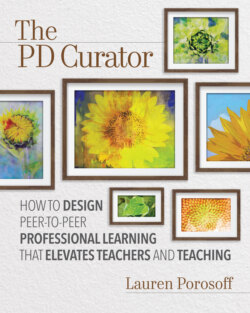The PD Curator

Реклама. ООО «ЛитРес», ИНН: 7719571260.
Оглавление
Lauren Porosoff. The PD Curator
The PD Curator
Table of Contents
Dedication
Acknowledgments
Introduction. A Case for Peer-to-Peer PD
Building Foundations for Professional Learning
Making Time for Peer-to-Peer PD
Using Scheduled Meetings
Arranging Substitute Coverage
Creating Opt-In PD Events
Structuring Teachers' Time
Figure 1.1. Questions About Structuring Teachers' Time
Orienting Teachers to Learning
Structuring Interactions to Promote Learning
Figure 1.2. Questions About Structuring Teachers' Interactions
Starting Small
Onward
Make It Inclusive. Preparing for Professional Learning
Limitations of Observing Teachers to Determine Their Expertise and Interests
Limitations of Asking Teachers About Their Expertise and Interests
Eliciting Teachers' Expertise and Learning Goals
Figure 2.1. Tools to Elicit Teachers' Strengths and Needs
Deictic Questions
Figure 2.2. Questions to Elicit Faculty Expertise
Figure 2.3. Questions to Elicit Faculty Needs
Significant Moments in My Life as an Educator
Figure 2.4. Sample Significant Moments Timeline
Secret Appreciators
Figure 2.5. Sample Appreciation Slip
Core Values Assessment
Figure 2.6. Core Values Survey Form
Knowledge Discovery
Growth Tracker
Figure 2.7. Growth Tracking by a Middle School Teacher
Figure 2.8. Growth Tracker Graphic Organizer
Toward Equity in Peer-to-Peer PD
Onward
Make It Participatory. Structuring Professional Learning
The Workshop
Figure 3.1. Workshop Planning Tool
The Council
Figure 3.2. Council Protocol
The Exemplar Study
Figure 3.3. Exploring Exemplars Chart
Figure 3.4. Exemplar Study Protocol
The Toolbox Share
Figure 3.5. Toolbox Share Protocol
Figure 3.6. Toolbox Share Note-Taking Organizer
The Intervision Group
Figure 3.7. Intervision Group Protocol
Figure 3.8. Intervision Note-Taking Organizer
The Bringback
Figure 3.9. Bringback Protocol
Building a Culture of Risk Taking
Sharing Responsibility for Success
Onward
Make It Cohesive. Organizing Professional Learning
Routinizing Professional Learning
Creating Professional Learning Units
Inquiry-Based PD Units
Figure 4.1. Sample PD Unit Plan for a Website Redesign Project
Figure 4.2. Sample PD Unit Plan for a Multicultural Curriculum Revision Project
Figure 4.3. Sample PD Unit Plan for a Classroom Management Project
Setting Teachers Up for Successful Projects
Creating Inquiry-Based PD Units
Using Essential Questions
Stimulating Teachers' Curiosity
Raising the Level of Discourse
Providing a Direction for the Unit
Planning Inquiry-Based Units
Figure 4.4. Inquiry-Based PD Planning Flowchart
Figure 4.5. Vulnerability Heat Map
Choosing a PD Unit Type
Practical Considerations in Unit Design
Pacing for Differentiation
Sending Follow-up Resources
Creating Successful Groupings
Assigning Roles
Celebrating Growth
Learning from Learners
Onward
Make It Effective. Assessing Professional Learning
Defining Effectiveness in Professional Learning
Assessing Whether PD Fulfilled Its Objectives
Figure 5.1. Sample Survey Assessing a Science Department Toolbox Share
Figure 5.2. Sample Survey Assessing a Flipped Classroom Workshop
Figure 5.3. Sample Survey Assessing Intervision
Assessing Whether PD Felt Meaningful and Satisfying to Participants
Figure 5.4. What Makes PD Meaningful?
Assessing Whether PD Shifts Faculty Culture
Supporting Strugglers and Stragglers
Supporting Teachers Who Excel
Onward
The Self-Reflective Curator
Recognizing Your Leadership Values
Figure 6.1. Examples of Values as Qualities of Action
Bringing Your Leadership Values to PD Curation
To-Do List Appraisal
Exercise
Figure 6.2. To-Do List Ratings
Reflection Questions
Responding to Disruptive Behavior
Figure 6.3. Circles of Compassion
Exercise
Reflection Questions
Values Alignment Check
Figure 6.4. Enacting My Leadership Values
Exercise
Reflection Questions
Building a Team of Curators
Conclusion. Stepping into the Curator Role
References
About the Author
Related ASCD Resources. Professional Development
Print Products
ASCD myTeachSource®
Whole Child
Whole Child Tenets
Study Guide
Introduction: A Case for Peer-to-Peer PD
Chapter 1. Building Foundations for Professional Learning
Chapter 2. Make it Inclusive: Preparing for Professional Learning
Chapter 3. Make it Participatory: Structuring Professional Learning
Chapter 4. Make it Cohesive: Organizing Professional Learning
Chapter 5. Make it Effective: Assessing Professional Learning
Chapter 6. The Self-Reflective Curator
Conclusion: Stepping into the Curator Role
Figure 2.2. Questions to Elicit Faculty Expertise
Figure 2.3. Questions to Elicit Faculty Needs
Отрывок из книги
How to Design Peer-to-Peer Professional Learning That Elevates Teachers and Teaching
Lauren Porosoff
.....
Chapter 1 discusses how to structure teachers' schedules to make time for in-house professional learning, along with how to set up their spaces to create a learning culture. Rather than encouraging large-scale changes, this chapter offers suggestions for how to use the resources you already have at your school.
Chapter 2 is about how to make professional learning inclusive. Just as museum curators can legitimize artists by including their work in a show, PD curators have the power to legitimize the work of diverse teachers and the entire teaching profession. Instead of only looking to "thought leaders" and hot topics for material worthy of study, you can discover talent inside your school building and deliberately elevate teachers' voices. The tools in this chapter are designed to help you build your awareness of faculty expertise, interests, goals, and needs, which you can then leverage in peer-to-peer PD.
.....